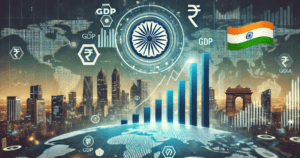India Set to Overtake Japan as 4th Largest Economy, Could Surpass Germany by 2027
India is on track to surpass Japan and become the world’s fourth-largest economy by the end of the 2024-25 financial year, according to the IMF. Over the past decade, India’s GDP has more than doubled, growing from $2.1 trillion in 2015 to an estimated $4.3 trillion by 2025. Currently ranked as the fifth-largest economy, India is closing in on Japan, which has a GDP of $4.4 trillion. While India’s economy has expanded by 105% in the last ten years, Japan’s growth has remained stagnant. If this momentum continues, India could surpass Germany (GDP: $4.9 trillion) by mid-2027.
India’s economic growth has outpaced major global economies, including China, the U.S., and several European nations. Over the past decade, China’s GDP grew by 76%, the U.S. by 66%, Germany by 44%, France by 38%, and the UK by 28%. Commerce Minister Piyush Goyal highlighted India’s exceptional performance within G7, G20, and BRICS nations. India took 60 years to reach a $1 trillion GDP in 2007 but has rapidly climbed since then, crossing $3 trillion in 2021 and expected to exceed $4.3 trillion in 2025. Experts predict that if this trend continues, India could reach a $10 trillion economy by 2032. However, the U.S. ($30.3 trillion) and China ($19.5 trillion) remain the world’s largest economies.

India Set to Overtake Japan as 4th Largest Economy, Could Surpass Germany by 2027
India is rapidly emerging as one of the world’s largest economies. According to the International Monetary Fund (IMF), India is expected to surpass Japan and become the fourth-largest economy by the end of the 2024-25 financial year. Over the past decade, India’s economy has grown significantly—from $2.1 trillion in 2015 to an estimated $4.3 trillion by 2025. This means the economy has more than doubled in size during this period.
Currently, India ranks as the fifth-largest economy, just behind Japan, whose economy is valued at $4.4 trillion. While India has experienced rapid growth, Japan’s economy has remained mostly stagnant in recent years. If India continues on this trajectory, experts believe it could also overtake Germany (with a $4.9 trillion economy) by mid-2027, securing the third spot globally.
India’s growth stands out even when compared to other major economies. Over the past decade, China’s economy expanded by 76%, the U.S. by 66%, and Germany by 44%. In contrast, India’s economy grew by an impressive 105%. Countries like France (38%) and the UK (28%) saw much slower growth. India’s Commerce Minister, Piyush Goyal, emphasized that the country’s economic progress has outpaced not only developed economies in groups like the G7 and G20 but also other emerging markets within the BRICS bloc.
India’s journey to becoming a $4.3 trillion economy has been remarkable. It took the country 60 years to reach its first $1 trillion in GDP in 2007. However, the next $1 trillion was added much faster—by 2014, just seven years later. Despite setbacks like the COVID-19 pandemic, India’s economy surpassed the $3 trillion mark in 2021. Now, it is on track to add another $1.3 trillion in just four years, reaching $4.3 trillion by 2025.
Looking ahead, analysts predict that India’s growth could accelerate even further. If the economy maintains its current pace, it could add $1 trillion every 1.5 years. This would push India’s GDP to $10 trillion by 2032. However, catching up to the world’s two largest economies—the U.S. ($30.3 trillion) and China ($19.5 trillion)—will take much longer.
India’s rise is the result of years of economic reforms, a young workforce, and the expansion of key industries such as technology and manufacturing. However, challenges like poverty, unemployment, and infrastructure limitations remain. To sustain its growth, India will need to address these issues while continuing to attract global investments.
In summary, India’s economic transformation over the past two decades has been extraordinary. From reaching its first $1 trillion milestone in 2007 to aiming for $10 trillion by 2032, the country is reshaping its role in the global economy. While challenges persist, India’s current momentum suggests it could soon stand alongside the U.S. and China as a major driver of worldwide economic growth.
You must be logged in to post a comment.